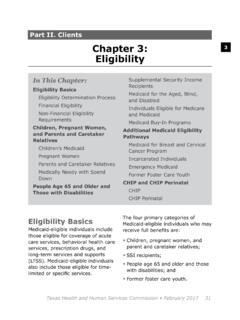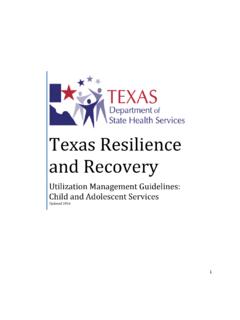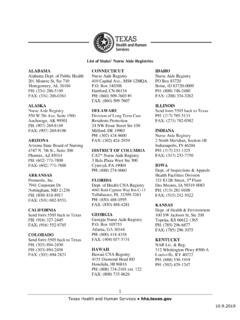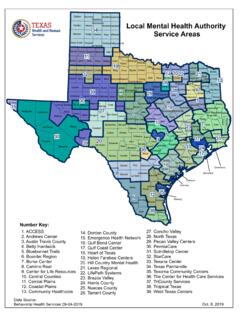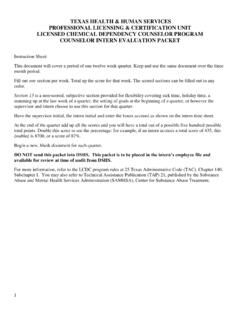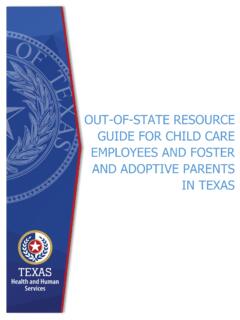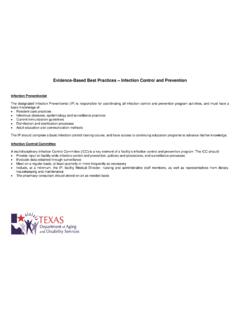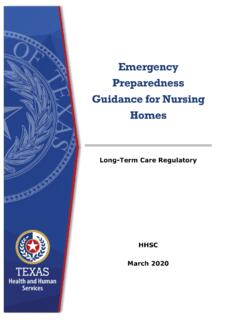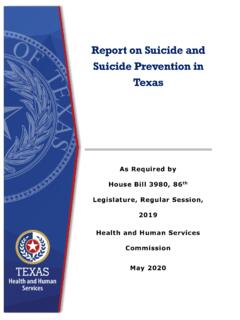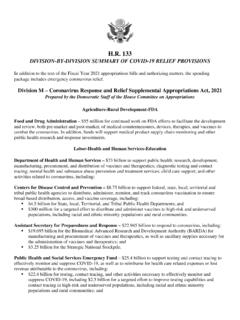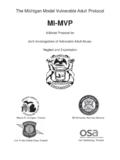Transcription of Abuse, and Exploitation (ANE) in Long Term Care
1 Abuse, Neglect, and Exploitation (ANE) in Long Term CareTexas Health and Human ServicesQuality Monitoring Program123 The Statistics of Elder AbuseWhat is ANE? Abuse is the WILLFUL infliction of injury, unreasonable confinement, intimidation, or punishment with resulting physical harm, pain or mental anguish: Physical Emotional Sexual Neglect or abandonment Exploitation45 Signs and Symptoms It may be difficult to recognize signs and symptoms of abuse, as they can often times appear to be symptoms of dementia or signs of the individual s frailty, mental deterioration, or disease process. Physical abuse: Unexplained injuries Broken bones Medication issues Refusal of visitors by the caregiver6 Signs and Symptoms Signs and symptoms (cont.) Emotional abuse: Control by the caregiver Odd behavior Sexual abuse: Bruises Sexually transmitted diseases Bleeding7 Signs and Symptoms Signs and symptoms (cont.)
2 Neglect: Weight loss Bed sores Long fingernails/soiled fingernails (with feces) Unsanitary living conditions Unsuitable/dirty clothing Unsafe living conditions Matted hair Exploitation Significant withdrawals Sudden changes in financial condition Missing items89 Types of Nursing Home Abuse and NeglectExamplesof ANE Performing a two person transfer with only one person, knowing that two people are required to be present. I have seen my roommate left lying in the bed for more than one hour with her behind exposed. I feel sorry for my roommate. They treat her so bad. She can t talk or walk . A male nurse grabbed me, slung me on the floor, and threw me into the bed. He was in a bad mood because we were short staffed, and he had to work two floors . You observe a nursing assistant knowingly postponing a resident s incontinent care to take a of ANE A resident spits at a caregiver as she feeds the resident breakfast.
3 In retaliation, the caregiver spits at the resident s face and yells, Don t you ever spit at me again! A resident refuses to get out of bed when encouraged with a gentle approach by a nurse to attend an activity session. The nurse then forcefully pulls the resident from a reclining to an upright position in his bed, pushes him out of his room, as the resident screams and cries to be left alone. After soiling her clothes and bedding, a resident is taken into the shower by a nursing assistant. The resident suffers from dementia and struggles with the assistant. The assistant sprays ice cold water directly into the face of the of ANE A wheelchair bound resident is taken to the bathroom and told by the nursing assistant to call when she is ready to return to her room. The resident rings the call bell and no one answers. Frustrated, the resident tries to get into her wheelchair by herself and falls and fractures her hip.
4 A resident repeatedly uses a call bell attempting to get attention. After several trips to the resident s room, the nursing assistant unplugs the call bell so the resident can no longer use it You know that a resident has bleeding gums, loose teeth and has had difficulty eating. The resident s dentures were stolen and the resident has not been taken to a of ANE A resident tells you that she needs to go to the bathroom as you walk past her. You are on your way to help another resident, so you tell her to hold on. When you walk past her again, she says she needs to go to the bathroom. You are still busy and tell her to hold on and you will help her when you are done. When you finally come back, she has already urinated in her brief. The call bell rings and instead of helping her (because she no longer needs to go to the bathroom) you tell her to hold on while you assist the other resident.
5 She is now sitting in her wheelchair in a soiled brief. 2 employees arguing and yelling in the hallway outside of a residents room. The argument is not about the resident that is in the room, however, the resident in the room becomes distressed by all of the shouting. When the residents son comes in later that day, the resident describes the situation. The son complains, stating that his mom has suffered emotional abuse due to the 2 employees of ANE The DON called me and said my mother had woken up with a bump, a red bump, on her forehead. When I got to the facility that morning, I found her horribly bruised on her face and [the backs of her] forearms. She looked as if someone had gone seven rounds with her, except she has advanced Parkinson s. The only movement she can make is to raise her arms like this [indicating she could raise them defensively in front of her face].
6 The facility said she must have gotten them [the bruises and contusions] falling against her bedrails, but she can t move independently in bed.. So then they said they didn t know how it happened .14 Examples of ANE You change the brief and clothes of a resident who has had an incontinent episode, however, you leave the draw sheet and bedding in place, even though it is also soiled. You are assisting Mr. Jones with his lunch when he tells you that he is done eating (even though he only took 2 bites of his food). You tell Mr. Jones that he needs to eat more food, to which he replies loudly I told you I was done . You get frustrated with Mr. Jones because you have other residents to assist. You raise your voice, shake your finger at him and say Do not yell at me Mr. Jones, now you are going to eat some more of your lunch .15 Examples of ANE Mr. Sonora was a 90 year old widower with dementia who, despite his memory and cognitive problems, was able to manage living on his own.
7 His wife died a few years earlier and he had no family living in the region, but his out of state relatives telephoned him regularly to make sure he was doing okay. The relatives became concerned about his well being after a married couple approached Samuel and offered to help him around the house and perform minor home repairs. Initially Mr. Sonora welcomed their assistance and the relatives were happy he was getting help but soon the couple had taken over supervising his care, controlling his money, and restricting his access to his family. The couple had written checks for tens of thousands of dollars from Mr. Sonora s bank account for maintenance work but there was no evidence of any work being performed at his of ANE1718 Recognizing Elder AbuseWho is most vulnerable? Many characteristics may cause one residentto be at a higher risk for abuse, than another: Gender Age Functional capacity Mental capacity19 Risk Factors Facility Risk Factors.
8 Abuse Prevention Policy Staff education and training Staff screening Staff stresses/burnout Staff ratio/turnover Deficiencies/Complaints Culture and Management Physical Environment20 Risk Factors Resident Risk Factors Unmet Needs Relationship Risk Factors Resident visitor frequency Resident staff interaction2122A World Free from Elder AbuseConsequences of ANE on the elderly Physical Effects persistent physical pain and soreness nutrition and hydration issues sleep disturbances Elders who experienced abuse, even modest abuse, had a 300% higher risk of death when compared to those who had not been abused Psychological Effects increased risks for developing fear/anxiety reactions, learned helplessness, and post traumatic stress syndrome The total direct medical costs associated with violent injuries to older adults (all cases of ANE in the ) are estimated to add over $ billion to the nation s annual health expenditures23 Preventing ANE Watching for warning signs that might signal abuse (bruising, soreness, agitation, fear, refusal to speak).
9 If you suspect abuse, report it. Making sure that the older adult is eating properly and taking required medications. A weakened older adult may not be able to think clearly about the care being given. Listening to the resident. Intervening when you suspect elder abuse. Educating others about how to recognize and report elder abuse. Adopt stress reduction practices. If you re having problems with substance abuse, get Administrative Code and ANE Title 40 Social Services and Assistance, Part 1 Department of Aging and Disability Services, Chapter 19 Nursing Facility Requirements for Licensure and Medicaid Certification, Subchapter G Resident Behavior and Facility Practice, Rule Incidents of Abuse and Neglect are to the Texas Department of Aging and Disability Services (DADS) and Law Enforcement Agencies by Facilities: (a) A facility owner or employee who has cause to believe that the physical or mental health or welfare of a resident has been or may be adversely affected by abuse, neglect, or Exploitation caused by another person must report the abuse, neglect, or Exploitation .
10 25 Texas Administrative Code and ANE Rule Incidents of Abuse and Neglect Reportable to the Texas Department of Aging and Disability Services (DADS) and Law Enforcement Agencies by Facilities (cont.): (b) Reports described in subsection (a) of this section must be made to DADS at 1 800 458 9858 and written reports must be sent to: DADS Consumer Rights and Services, Box 14930, Austin, Texas 78714 9030. (1) The person reporting must make the telephone report immediately on learning of the alleged abuse, neglect, Exploitation , conduct, or conditions. The person must send a written report to DADS Consumer Rights and Services within five days after the telephone report. (2) The facility must conduct an investigation of the reported act(s). The facility must send a written report of the investigation to DADS no later than the fifth working day after the oral report. 26 Texas Administrative Code and ANE Rule Incidents of Abuse and Neglect Reportable to the Texas Department of Aging and Disability Services (DADS) and Law Enforcement Agencies by Facilities (cont.)
